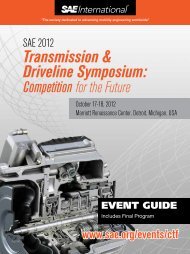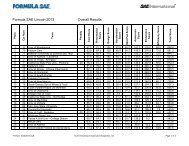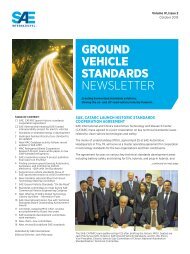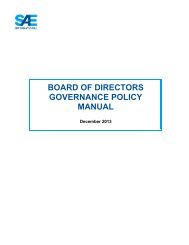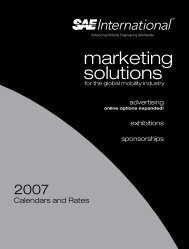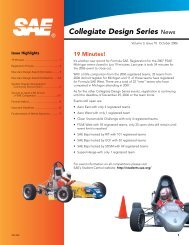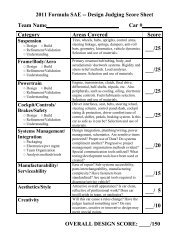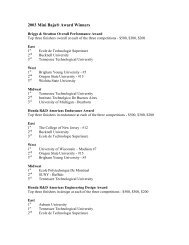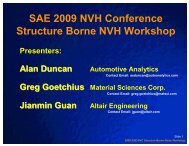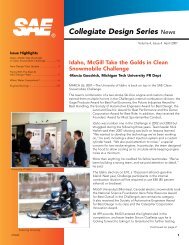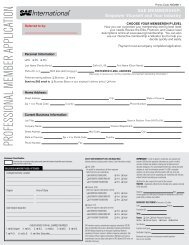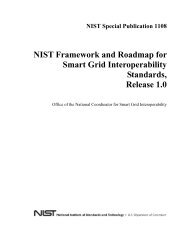Wednesday - SAE
Wednesday - SAE
Wednesday - SAE
Create successful ePaper yourself
Turn your PDF publications into a flip-book with our unique Google optimized e-Paper software.
Powering the future<br />
The dominant power source for at<br />
least the next 10 years remains the<br />
internal combustion engine, but the<br />
reigning technology after that<br />
timeframe is debatable.<br />
Tomorrow’s technology may be<br />
defined by a frantic fuel-cell takeoff.<br />
The solid oxide fuel cell (SOFC) being<br />
developed by Delphi may be just<br />
such an application. “By increasing<br />
power, reducing packaging, and<br />
eliminating the battery, SOFC adds<br />
the most near-term value for electric<br />
propulsion,” said Jean Botti, Chief<br />
Technologist at Delphi’s Innovation<br />
Center, during the “Powering The<br />
Future” panel in the AVL Technology<br />
Theater on Monday.<br />
Mike Rosenberg, Director of<br />
Corporate Relations for Ballard<br />
Power Systems, rallied for fuel cells<br />
that use hydrogen “because it’s a<br />
manufactured fuel.” He added that<br />
hydrogen fuel cells are no longer in<br />
the research and development stage<br />
as fleet demonstrations are in<br />
progress. “We think fuel cells are the<br />
ultimate solution,” Rosenberg added.<br />
Powering the Future panelists were<br />
(from left to right) Toyota’s Kazuo<br />
“Joe” Tomita; Ballard’s Mike Rosberg;<br />
GM’s Robert Purcell; DaimlerChrysler’s<br />
Reginald Modlin; Delphi’s Jean Botti;<br />
and moderator Ken Baker of Altarum.<br />
Hybrid-electric vehicles (HEVs)<br />
are in the power-source mix.<br />
“HEVs will occupy carefully<br />
defined market niches,” said<br />
Reginald Modlin, Director of<br />
Environmental & Energy Planning<br />
for DaimlerChrysler, citing high<br />
fuel economy or performance<br />
enhancers, or a combination of<br />
both reasons, as the primary<br />
appeal factors for such vehicles.<br />
Rather than predict the future,<br />
Robert Purcell, Group Director of<br />
Planning & New Business Development<br />
for GM Powertrain, said<br />
partnering for tomorrow is one<br />
way to address the fundamental<br />
challenges inherent with the<br />
technology adoption. The General<br />
Motors/Ford front-wheel-drive sixspeed<br />
automatic transmission is a<br />
prime example of how partnering<br />
with other companies can prove<br />
out a technology until it’s commercially<br />
viable. Technologies that<br />
become industry standards are not<br />
the “low-volume exclusive<br />
programs,” said Purcell.<br />
According to Purcell, the future<br />
means more industry collaboration<br />
such as the GM Powertrain<br />
Advanced Hybrid System II, which<br />
has accumulated more than one<br />
million miles in a city bus application.<br />
Purcell invited companies to<br />
partner on the system, which “we<br />
intend to be an industry standard.”<br />
In the meantime, today’s<br />
vehicles are a “very, very evolved<br />
product,” said Kazuo “Joe”<br />
Tomita, Senior Vice President of<br />
Technical & Regulatory Affairs for<br />
Toyota Motor North America, Inc.<br />
Tomita’s believes that, in choosing<br />
future powering technologies, a<br />
reality check is necessary. “The<br />
painful reality is that, unless clean<br />
technologies can be sold in<br />
volume, they will do nothing to<br />
improve air quality. A companion<br />
truth is that products must be<br />
profitable or “do-gooders go<br />
bankrupt.”<br />
Kami Buchholz<br />
16 4<br />
<strong>Wednesday</strong>, March 10, 2004



